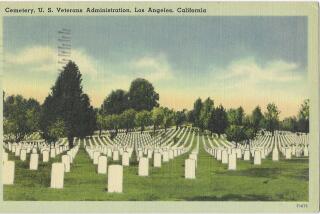Cemetery: Methods of Locating Historic Site
- Share via
Your article incorrectly attributes to me comments regarding the use of radar for detecting underground objects (“Cemetery Dispute Mars Housing Plan,” Aug. 11). First, I did not discuss the use of radar with your writer, Susan Woodward. However, I did discuss the use of magnetometer testing and indicated that this technique would not be effective on the project area. Let me explain.
Subsurface artifacts and features affect the local magnetic field. Archeologists use a magnetometer to detect these field differences to pinpoint the location of artifacts and features. Where field anomalies are detected, one can excavate to discover the artifacts and features.
This technique is ineffective in an area where artifacts and features coexist with other material that also affects the local magnetic field. The magnetometer cannot tell the difference between a soldier’s belt buckle and a modern railroad spike. It will detect them both. If there are hundreds of spikes and only one buckle, hundreds of locations would need to be probed.
At the project location, the area is contaminated with construction materials, has a railroad line running through it and is proximate to electrical power lines. All of this would contribute to multiple false readings on a magnetometer. These false readings would mask the presence of a small cemetery and related artifacts. In short, the use of a magnetometer would not solve this “needle in a haystack” problem.
On another issue, the “map” which is shown in the photo is not the 1872 map to which your writer refers. What is being displayed is based upon a re-creation of the Drum Barracks compound by a museum volunteer. The re-creation was itself based partly upon an 1872 drawing of the compound prepared by Lt. David Craigie as part of an inventory of buildings and materials to be sold at public auction. The Craigie rendering of the compound contained several scaling errors which seriously undermine its usefulness for determining the cemetery location within the bounds of Drum Barracks. However, the museum volunteer did not take the scaling errors into account and plotted the cemetery in a location which cannot be justified.
The Drum Barracks Museum continues to reproduce pamphlets which show this erroneous plotting of the cemetery. In point of fact, there is nowhere in the records, National Archives or other, a precise location of the cemetery. The Drum Barracks Museum personnel admit this fact (in print, this article) and yet continue to disregard the findings of both our archival and field work.
As archeologists, we are disappointed not to have found the historic cemetery, especially one of such significance in its association with the Drum Barracks. Such a historic feature is capable of providing invaluable data as to the health status, cause of death, method of burial, etc., of the affected individuals. Identification of the remains and their removal to a military or other protected cemetery would also have been possible.
In short, finding the cemetery would have been both interesting and worthwhile. However, focusing on an erroneous location is not productive. Future attention might be better directed toward the preservation and protection of those portions of the Drum Barracks compound that have not been developed.
CAROL DEMCAK
Rancho Palos Verdes


